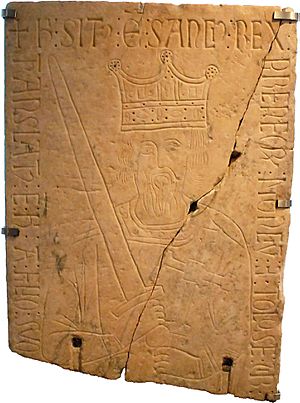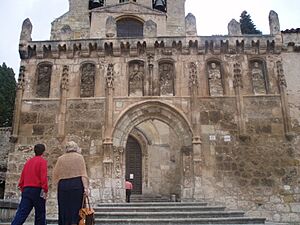Monastery of San Salvador de Oña facts for kids
The Monastery of San Salvador was a very old Benedictine monastery. It was built in the town of Oña, in central Spain. This special place was founded in the year 1011. It served as a monastery for many centuries, until the 1800s.
Contents
History of the Monastery
Early Days as a Benedictine Home
The monastery was started by Sancho García, who was the Count of Castile. He built it in 1011 for his daughter, Tigridia. It was a unique "double monastery," meaning it had both nuns and monks living there. The nuns came from a monastery in Cillaperlata. The monks came from a monastery in Loberuela.
In 1033, King Sancho III of Pamplona gave the monastery to the Abbey of Cluny. Cluny was a very large and important group of monasteries at that time. Because of this, San Salvador grew a lot. It eventually controlled over 70 other monasteries and churches.
In 1506, the monastery joined a group called the Benedictine Congregation of Valladolid. This group wanted to make monastic life stricter again. They followed the rules of Rule of Saint Benedict very closely. The monastery was badly damaged during the Peninsular War (a war during the time of Napoleon). Because of the war, the monks had to leave.
A famous monk from the 1500s was Dom Pedro Ponce de León. He is thought to be the first person to teach deaf people. He even started a school for them right at the monastery!
The Monastery in Modern Times
In 1835, the monastery's main church became a parish church. This meant it was used by the local people in the town. In 1880, the Catholic Church got the monastery property back. The Society of Jesus, also known as the Jesuits, then took over the buildings. They lived there for almost 90 years.
In 1968, the Province of Burgos took ownership of the monastery complex. For a while, it was even used as a psychiatric hospital.
In 2012, a group called Las Edades del Hombre (The Ages of Humankind) held a big art show there. The show was called Monasticus, which means "Monastic."
Monastery Architecture
The monastery buildings you can see today are a mix of different styles. Some parts are from the 12th century, built in the Romanesque style. This style was common in Cluny monasteries. Other parts show Gothic changes made in the 15th century.
The main gate to the monastery is a great example of the Mudéjar style. This style mixes Christian and Islamic art.
The church inside the monastery is very large. It is about 83 meters (272 feet) long and 20 meters (65 feet) wide. It is also 20 meters tall. It was updated in the 15th century. You can see paintings inside that are believed to be by a monk named Dom Alonso of Zamora.
In the sanctuary area, there is a beautiful Renaissance-era altarpiece. It shows the Immaculate Conception. There are also pieces from an older medieval altarpiece that it replaced. The choir area has a domed ceiling built around 1460. An opening was made in the 1700s to hold the relics (special remains) of St. Íñigo of Oña. He was one of the first leaders, or abbots, of the monastery. The wooden choir stalls there were carved by Dom Pedro of Valladolid.
The Crypt: A Royal Burial Place

The crypt is an underground room often used for burials. The Monastery of San Salvador became the final resting place for many important people from northern Spain. This was especially true in its early years.
Some of the important people buried there include:
- Count Sancho García of Castile (died 1017), who founded the monastery.
- Countess Urraca Gómez, his wife.
- Count García Sánchez of Castile (1009-1028), their son. He was the last independent Count of Castile.
- King Sancho III of Pamplona (992-1035).
- Queen Muniadona of Castile (died 1066), his queen and daughter of Count Sancho García.
- King Sancho II of Castile and León (1036/8-1072).
- Infante García of Castile (1142-1146), son of King Alfonso VII of León.
- Infante Philip (1292-1327), son of King Sancho IV of Castile.
See also
 In Spanish: Monasterio de San Salvador de Oña para niños
In Spanish: Monasterio de San Salvador de Oña para niños
- List of Jesuit sites



